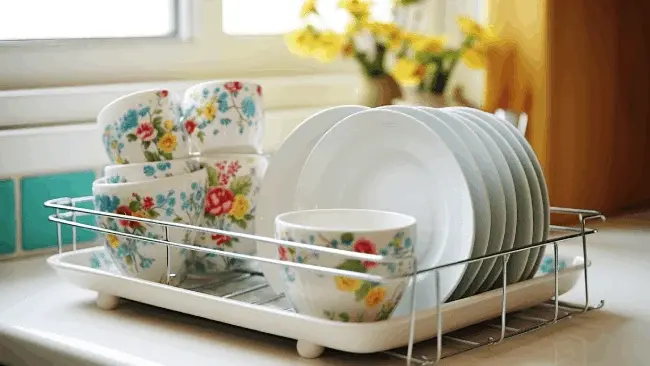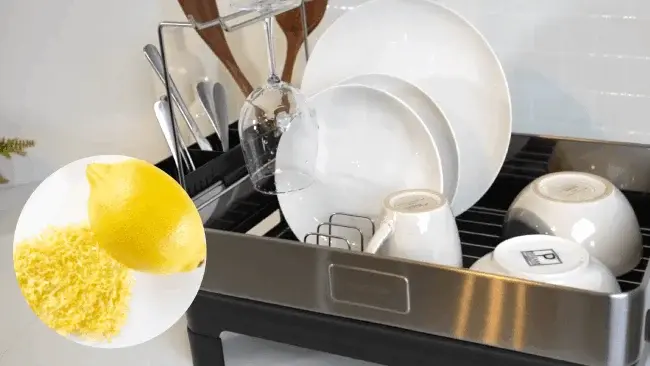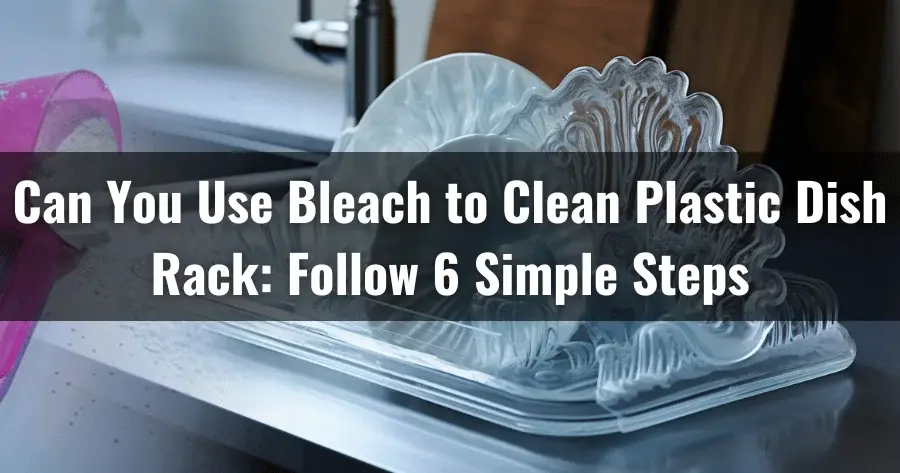The plastic dish rack stands out in the kitchen for keeping your dishes organized and dry. Eventually, dish racks will accumulate dirt, grime, and mold, requiring thorough cleaning. But can you use bleach to clean the kitchen plastic dish rack?
You can use bleach to clean a plastic dish rack, effectively killing germs and removing stains. To do this, prepare the cleaning solution by combining dish detergent and ¼ cup of household bleach in a sink or basin filled with warm water.
Next, soak the solution’s drain board and utensil holder for about ten minutes to loosen any grime or stains. Then, scrub and rinse the drain board thoroughly using a dishcloth or sponge. After that, clean and rinse the utensil holder using the same method.
Here, we will discuss the wonders of bleach and how it can be used effectively to clean your plastic dish rack.
Jump to Section
How Can You Use Bleach to Clean Plastic Dish Racks?

You will need some materials for cleaning your plastic dish rack with bleach, such as dish detergent, household bleach, and a dishcloth or sponge. After gathering the materials, simply follow our well-researched six steps:
Step 1: Prepare the Cleaning Solution
Start by filling your sink with warm water and adding ¼ cup of household bleach to the water. And then, adding warm water helps activate the bleach and ensures it is evenly distributed throughout the sink.
Step 2: Soak the Drain Board and Utensil Holder
Place the utensil holder and the drain board in the sink filled with the bleach and detergent solution. We recommend soaking for 10 minutes to loosen dirt and grime for the best results. Soaking drain boards and utensil holders ensures that every nook and cranny is thoroughly cleaned.
Step 3: Scrub and Rinse the Drain Board
After soaking, scrub the drain board with a sponge or dishcloth to remove any remaining dirt or residue. Make sure to scrub the drain board’s front and back thoroughly.
This will help eliminate any stubborn stains or grime accumulated over time. Use gentle but firm strokes to ensure effective cleaning without damaging the plastic material.
Once you have finished scrubbing, rinse the drain board in clean water to remove any traces of bleach and detergent solution. It helps prevent chemical residue from contacting your dishes or utensils later.
After rinsing, place the drained board on a dishtowel flat to air dry completely before storing it away or using it again.
Step 4: Clean and Rinse the Utensil Holder
To thoroughly clean the utensil holder, scrub it to remove dirt or grime. Use a non-abrasive sponge or brush and some dish soap. Pay special attention to areas under lips or edges and within the tiny drain holes at the bottom. Make sure to reach every nook and cranny.
Once you’ve scrubbed away any dirt or grime, rinse the utensil holder in clean water. After rinsing, place the utensil holder on a dishtowel to air dry completely before using it again. According to our research, adding vinegar to the rinse water helps keep the utensil holder looking and smelling fresh.
Step 5: Clean the Dish Rack
Start by removing the rubber-lined tray at the dish rack’s bottom. Then submerge your plastic dish rack into the soapy water and bleach solution, allowing it to soak for approximately 10 minutes.
Soapy water and bleach are ideal for removing stubborn stains, grease, and grime from dish racks.
As the dish rack soaks, the bleach will work to disinfect and sanitize the plastic surface, killing any bacteria or germs that may be present.
Step 6: Scrub and Rinse the Dish Rack

While scrubbing the dish rack, we advise paying attention to any crevices or corners where dirt and residue might accumulate. Use a sponge or dishcloth to scrub the entire surface of the dish rack thoroughly.
Upon completion of the scrubbing process, rinse the dish rack under clear water to eliminate any remaining bleach and detergent solution. This ensures that no harmful chemicals are left behind on the plastic surface of the dish rack.
Finally, place the rinsed dish rack on a dishtowel on a flat surface and let it air dry completely.
Following these steps will help keep your plastic dish rack clean and safe for use in your kitchen.
FAQ’s
Here are some of the most frequently asked questions we found while researching this article about cleaning plastic dish racks:
1. Can I use bleach on colored plastic dish racks?
Using bleach on your colored plastic dish racks can potentially cause fading or discoloration, so we strongly suggest testing a small area first. To do this, dilute the bleach solution and apply it to an inconspicuous spot on the rack. Allow it to sit for a few minutes, then wipe it off with a clean cloth.
Check for any changes in color or damage. If there is no noticeable fading or discoloration, you can proceed with using the diluted bleach solution to clean the entire dish rack.
If there is any negative reaction, avoid using bleach and opt for alternative cleaning methods such as soap and water or vinegar solutions.
2. How often should I clean my plastic dish rack with bleach?
The frequency of cleaning with bleach depends on the level of grime, mold, or mildew buildup you notice. As a general guideline, kitchen experts are recommended to clean your plastic dish rack with bleach every few weeks or as needed.
Regularly inspect your dish rack for any visible signs of dirt or growth that could compromise its cleanliness and hygiene. If you notice any such buildup, you should promptly address it with bleach.
3. Is it safe to use bleach on a plastic dish rack that has metallic parts?
To ensure the safety of your plastic dish rack with metallic parts, take care when applying bleach due to its potential to corrode or discolor metal over time.
Bleach is a powerful cleaning agent that effectively removes stains and kills bacteria on plastic surfaces. But, when it comes into contact with metal components, it can cause damage. To avoid this, follow our simple tricks:
- Focus on applying the bleach solution primarily on the plastic parts of your dish rack. Afterward, rinse thoroughly to prevent any leftover bleach from coming into contact with the metal.
- You can use a mild soapy solution or a specific metal cleaner suitable for the type of metal used in your dish rack to clean the metallic components.
4. Can I mix lemon with bleach for cleaning plastic dish racks?

Do not mix lemon with bleach to clean your plastic dish rack. It is strongly advised to avoid combining acidic substances like lemon juice with bleach, as it produces toxic fumes and can result in dangerous reactions.
Bleach is a highly reactive chemical, and when exposed to acids, such as those in lemon juice, it releases chlorine gas, causing respiratory problems.
If you want to remove bleach odors from your plastic dish rack using lemon juice, do it separately from bleach-containing products. Before using a lemon solution, rinse and let the rack dry completely.
So, it’s crucial to be cautious of using lemon juice and bleach together while cleaning your plastic dish rack.
5. How can I prevent mold and mildew on my plastic dish rack?
Ensure your dish rack is completely dry after each use to prevent mold and mildew from forming. Moisture is the primary factor contributing to mold and mildew growth, so it’s important to eliminate any excess moisture on your plastic dish rack.
After washing your dishes, thoroughly wipe down the dish rack with a clean towel or cloth to remove any remaining water droplets. Also, consider placing the dish rack in an area with good air circulation or near a window to allow for faster drying.
Conclusion
From the entire discussion, we understand that using bleach to clean a plastic dish rack is an effective and efficient method.
Mixing one tablespoon of bleach with one gallon of water, you can create a cleaning solution to disinfect and remove stains from the rack. And ensure that you rinse the dish rack thoroughly after cleaning to ensure no residue remains.
A study by the International Association for Food Protection found that bleach kills 99.9% of bacteria on surfaces. So, we must say bleach is an excellent choice for keeping your kitchen clean.





